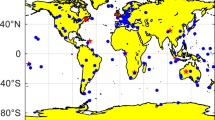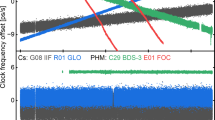Abstract
High-precision estimates of GPS satellite clock errors reveal systematic sub-daily clock bias variations on the order of 1 ns. The low noise levels in the Rubidium Atomic Frequency Standards onboard GPS IIR, IIR-M, and IIF satellites provide visibility of these small, but systematic behaviors. Prior studies have reported on this phenomenon and sought to characterize the specific frequency components present and to identify potential causes of the observed periodic variations. Our research focuses on the repeatability of the clock variations and the potential for using observed variations directly to predict future clock behavior. Results are presented and compared to IGS Ultra-rapid and broadcast message predictions for all operating GPS satellite clocks for a 1-month period in July 2017. During this time, the accuracy of the proposed sub-daily variation prediction is better than 0.15 ns (RMS) for 8 out of 9 GPS Block IIF Rb clocks and under 0.3 ns (RMS) for most GPS IIR and IIR-M Rb clocks. This approach is complementary to existing techniques for estimating longer-term clock rates and drift and can be combined with them to improve the fidelity of predictive satellite clock models for real-time GPS position, navigation, and timing applications.












Similar content being viewed by others
References
Axelrad P, Larson KM, Jones B (2005) Use of the correct satellite repeat period to characterize and reduce site specific multipath errors. In: Proceedings of ION GNSS-2005, Long Beach, CA, pp 2638–2648
Beard R, White J, Brad J, Myers T, Reid W, Danzy F, Buisson J (2000) Long term ground test results for two GPS Block IIR rubidium clocks. In: Proceedings of ION NTM 2000, Anaheim, CA, pp 381–387
Choi K, Bilich A, Larson KM, Axelrad P (2004) Modified sidereal filtering: implications for high-rate GPS positioning. Geophys Res Lett 31:L22608. https://doi.org/10.1029/2004GL021621
Davis J, Bhattarai S, Ziebart M (2012) Development of a Kalman filter based GPS satellite clock time-offset prediction algorithm. Eur Freq Time Forum (EFTF). https://doi.org/10.1109/EFTF.2012.6502355
Dow JM, Neilan RE, Rizos C (2009) The international GNSS service in a changing landscape of global navigation satellite systems. J Geodesy 83:191–198. https://doi.org/10.1007/s00190-008-0300-3
Dupuis RT, Lynch TJ, Vaccaro JR, Watts ET (2010) Rubidium frequency standard for the GPS IIF program and modifications for the RAFSMOD program. In: Proceedings of ION GNSS + 2010, Portland, OR, pp 781–788
Epstein M, Dass T (2001) Management of phase and frequency for GPS IIR satellites. In: Proceedings of the 33th annual precise time and time interval systems and applications meeting, Long Beach, California, pp 481–492
GPS (2008) Global positioning system standard positioning service performance standard, 4th edn, September 2008
Huang GW, Zhang Q, Xu GC (2014) Real-time clock offset prediction with an improved model. GPS Solut 18(1):95–104
IGS (2014) Real-time service fact sheet. http://rts.igs.org/monitor/
Montenbruck O, Hugentobler U, Dach R, Steigenberger P, Hauschild A (2012a) Apparent clock variations of the Block IIF-1 (SVN62) GPS satellite. GPS Solut 16(3):303–313
Montenbruck O, Steigenberger P, Schönemann E, Hauschild A, Hugentobler U, Dach R, Becker M (2012b) Flight characterization of new generation GNSS satellite clocks. Navigation 59(4):291–302
Parkinson BW, Enge PK (1996) Differential GPS. In: Parkinson BW, Spilker JJ (eds) Global positioning system: theory and applications, vol II. AIAA, Reston, VA
Riley WR (2008) Handbook of frequency stability analysis. NIST special publication 1065 National Institute of Standards and Technology, Boulder, CO
Senior KL, Coleman MJ (2017) The next generation GPS time. Navigation 64(4):411–426
Senior K, Ray JR, Beard RL (2008) Characterization of periodic variations in the GPS satellite clocks. GPS Solut 12(3):211–225. https://doi.org/10.1007/s10291-008-0089-9
van Diggelen F (2009) A-GPS, assisted GPS, GNSS, and SBAS. Artech House, Boston, MA
Vannicola F, Beard R, White J, Senior K, Kubik K, Wilson D (2010) GPS block IIF rubidium frequency standard life test. In: Proceedings of the 23rd international technical meeting of the satellite division of the ION GNSS + 2010, Portland, OR, pp 812–819
Wang YP, Lu ZP, Qu YY, Li LY, Wang N (2017) Improving prediction performance of GPS satellite clock bias based on wavelet neural network. GPS Solut 21:523–534
Acknowledgements
The authors would like to thank the anonymous reviewers for their valuable comments and recommendations and Dr. Ben Bradley and Dr. John Pratt for their MATLAB codes used in support of this work.
Funding
Funding for a portion of this work was provided by Braxton Technologies LLC (Subcontract No. 1059‐2015‐1).
Author information
Authors and Affiliations
Corresponding author
Rights and permissions
About this article
Cite this article
Strandjord, K.L., Axelrad, P. Improved prediction of GPS satellite clock sub-daily variations based on daily repeat. GPS Solut 22, 58 (2018). https://doi.org/10.1007/s10291-018-0723-0
Received:
Accepted:
Published:
DOI: https://doi.org/10.1007/s10291-018-0723-0




